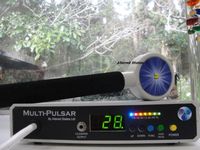Radical Prostates
Female hormones may play a pivotal role in a distinctly male epidemic
By JANET RALOFF
Estrogen remains one of the strongest and best-characterized risk factors for breast cancer, the second leading cause of cancer deaths in U.S. women. The greater a woman's lifetime exposure to this quintessential female sex hormone, the greater her chance of developing the disease.
Fewer details have emerged to explain breast cancer's counterpart in men -- prostate cancer, the most prevalent male malignancy and second leading cause of cancer deaths in men. Prostate cancer afflicts some 50 to 70 percent of men in Western countries by age 70, and the incidence of the disease is on the rise. Each year now, in the United States alone, some 244,000 new cases are diagnosed and 44,000 men die from the cancer.
While physicians have yet to find an effective prevention strategy for prostate cancer, one is "desperately needed," says William G. Nelson of the Johns Hopkins Medical Institutions in Baltimore.
Ironically, one of the newer avenues in breast cancer research may offer some unanticipated payoffs here. Growing evidence suggests that both malignancies trace to a common mechanism -- damage to DNA. Such damage can be triggered, at least in part, by estrogen.
One observation unites researchers attempting to flesh out this provocative theory: a consistent finding of extensive oxidation in the tissue where prostate cancers form. This oxidation is caused by free radicals -- short-lived molecular fragments that damage cellular proteins and DNA by chemically altering them. The magnitude of this oxidative damage increases with age, as does the incidence of prostate cancer.
This free radical model "is a very neglected area in prostate cancer research," according to Shuk-mei Ho, an endocrine oncologist at Tufts University in Medford, Mass. To date, she says, the search for the mechanisms behind this cancer has focused primarily on male sex hormones and their effects on genes.
Yet Ho and others have recently begun demonstrating that hormones can play unexpected roles in this tissue. Indeed, the hostile, free-radical-laden environment that hormones might foster in the prostate could go a long way toward explaining cancer's development there.
The association of free radicals with aging in prostate tissue has already spurred the development of a new, more precise technique not only for diagnosing prostate cancer, but also for finding evidence of the DNA damage that may precede it. New findings in this area suggest that dietary and other antioxidant therapies may hold great promise for curbing this scourge.
Critical to reproduction, the prostate produces the seminal fluid that carries
sperm cells. Wrapped around a man's urethra, the tube that carries urine
from the bladder, this walnut-sized, muscular gland grows under the influence
of testosterone and other male sex hormones, or androgens. Indeed, cancer
does not develop in this tissue unless it has access to androgens.
However, the notion that androgens alone are responsible for most prostate cancers does not make sense, argues Joachim G. Liehr, a pharmacologist at the University of Texas Medical Branch in Galveston. "If they were," he says, "young men at 18 or 20 -- the peak of androgen production -- should be getting the disease." In fact, he notes, the cancer tends to strike in middle to old age, when testosterone concentrations are waning.
Men's estrogen production, in contrast, does not fall in old age. Indeed, Liehr notes, it may even creep up a bit. Together, these changes cause a dramatic shift in the ratio of testosterone to estrogen, a turn he believes may foster this cancer.
That suspicion is shared by Maarten Bosland at the New York University Medical Center in Tuxedo. Though estrogens have been used to treat prostate cancer, he notes that recent animal studies indicate that these hormones may actually enhance testosterone's threat to the prostate.
For instance, Bosland gave young, castrated male rats enough estrogen to produce concentrations equivalent to those naturally present in females. These male rats, which could no longer produce testosterone, developed no prostate cancers. When he replaced the missing testosterone in another group of young, castrated males, some 20 to 30 percent eventually developed malignant prostate tumors. When he administered both hormones, however, up to "100 percent got prostate cancer -- a remarkable increase."
What was the estrogen doing? According to Liehr, it was probably damaging the prostate by bathing it in chemicals produced by the breakdown of estrogen, a process that can unleash free radicals.
As the body uses, or breaks down, estrogen, a host of related compounds is
formed. Working both with animals and with cells grown in test tubes, Liehr
has shown that in certain female reproductive tissues, such as the breast
and uterus, estrogen can be transformed into 4-hydroxy estradiol (4-HE).
This compound is a potent source of free radicals, he points out. Moreover,
unlike other estrogen breakdown products, this one resists further degradation,
so it can reach high concentrations.
Liehr suspects that the prostate also converts estrogen to 4-HE. If so, that could explain much of the free radical damage seen in aging prostates.
Though Ho agrees, she notes that other processes can also foster the buildup of oxidative damage in the prostate. For instance, as cells grow and use energy, they take in oxygen -- and generate free radicals. Enzymes in the cells normally produce antioxidants that limit damage by these radicals. Ho notes that these enzymes tend to malfunction in cancerous prostates.
Nelson and his colleagues at Johns Hopkins, for instance, have found that the gene responsible for activating one family of enzymes that detoxify free radicals is turned off in every sample of cancerous prostate tissue they've studied. Ho's team has examined five other antioxidant enzymes in the prostates of elderly rats. In every case, she says, enzymatic activity drops with age, rendering these animals more vulnerable to injury by free radicals.
That injury is extensive. Indirect measurements show that the prostates of male rats approaching late middle age, for instance, exhibit 500 to 700 times as much free radical damage as those of young animals.
What makes this particularly worrisome, notes Donald C. Malins of the Pacific Northwest Research Foundation in Seattle, is that much of the damage involves DNA as well as nonreplicating cell structures.
The damage goes beyond rodents. Malins has found extensive DNA damage induced by free radicals in the prostates of men. The severity of that damage depended on whether a man's tissue had been normal, abnormal though benign, or malignant (see sidebar).
Further linking free radical damage to disease, Bosland's animal studies show that "tumors in the prostate develop only in that region where you find elevated levels of oxidative damage."
Estrogen may or may not be a primary source of the free radicals in the prostate.
In either case, Ho sees a pivotal role for this hormone in cancers that develop
there.
In many other tissues of the body, old cells are constantly replaced. If a cell scheduled for replacement is damaged, the body often shuts down that cell's regenerative cycle before a defective copy is made.
Ho says that two factors work against the prostate in this regard. First, its cells go into a quiescent, nonreproducing phase that lasts decades. In men, it begins shortly after the organ reaches adult size and continues to about age 50 or 60. Throughout this period, its cells are continuously -- and increasingly -- bombarded by free radicals.
The accumulating damage "is like a time bomb," Ho says. "But to set the time bomb off, you have to reactivate cell proliferation in the prostate." She believes that the increased estrogen-to-testosterone ratio that develops in old age somehow triggers a resumption of prostate growth.
Yet even that might not be so bad if the prostate identified the damaged cells and chose not to copy them. In prostate cancer, this decision-making apparatus "appears messed up," Ho says. "So these cells copy their faulty DNA, allowing their progeny to carry the wrong information." That misinformation can lead to malignancy.
The free radical theory of prostate cancer may explain recent dietary observations. Several studies have found that men taking vitamin E, a potent antioxidant, are far less likely to develop prostate cancer than men who don't supplement their diets with the vitamin, Ho notes. She also cites several studies showing that diets rich in tomatoes appear to confer some protection against the cancer. Lycopene, one of the carotenoid pigments in tomatoes, is a well-known antioxidant.
Another recent study suggests that selenium -- an antioxidant present in seafood, certain organ meats, and grain -- may also reduce a man's risk of developing this cancer.
Taken together, Malins says, "the possibility exists to either retard or possibly roll back radical-induced DNA damage by the administration of antioxidants," either through diet or drugs.
Bosland intends to explore another dietary approach. He and others have shown that genistein, a compound in soy protein that blocks much of estrogen's activity in people, inhibits the growth of prostate cancer cells. During the next few weeks, he plans to begin a human trial with surgically treated patients who had had advanced prostate cancer. The men will eat soy to see if it prevents the return of the cancer or slows the progression of any recurrent disease.
Diagnosing the impacts of battered DNA
Using a novel statistical technique that his group pioneered earlier for the
analysis of DNA damage induced by free radicals in breast tissue, Donald
C. Malins of the Pacific Northwest Research Foundation in Seattle says that
his group has been able "to classify prostate tissue as normal or cancerous
with 100 percent certainty."
The researchers extracted the DNA from biopsied tissue, irradiated it with infrared light under a microscope, and measured the spectra reflected back. They then "performed something like 1.2 million [statistical] correlations on each spectrum" to find a few principal components that account for perhaps 80 percent of the variation in spectra between men, Malins explains.
Spectral data for DNA from normal tissues were consistent. Those from DNA in abnormal or cancerous tissue varied dramatically. Based on similar changes seen in breast tissue subjected to free radical damage, these appear to represent "substantial structural alterations in the DNA," Malins told Science News.
By assigning a numerical value to three principal components in the spectrum from each DNA sample analyzed, Malins' group has been able to display its data for each man as a point in three-dimensional space. The resulting map looks like stars scattered throughout the sky. Those representing DNA from men with cancers clustered into a distinct, confined galaxy. Those from men with benign prostate abnormalities formed a second constellation, they report in the Jan. 7 Proceedings of the National Academy of Sciences. A third cluster represented men with no prostate disease.
Some men with ostensibly normal prostates exhibited significant DNA damage without incurring major structural change. Malins interprets this as indicating that the DNA can sustain quite a lot of hits before it suddenly "flips" into a new shape. It's analogous, he says, to a brick wall that's being battered with a sledge hammer. The wall will continue to stand, even as cracks form, the mortar begins falling away, and a few bricks crumble. Then, at some critical point, a single hammer blow reduces a large portion of the wall to a new form -- a pile of rubble.
By graphing free radical damage in normal and diseased tissue, Malins believes he's homing in on that major structural switching point. If confirmed, the position of a patient's DNA on the three-dimensional chart might offer diagnostic information on whether his prostate is healthy, contains a cancer, or has sustained damage likely to cause a carcinogenic transformation.
Earlier findings by Malins' group showed that DNA from a breast cancer that is able to spread exhibits a distinctive signature (SN: 3/23/96, p. 182). Such cancers map their own galaxy in that star chart, one quite different from the cluster representing noninvasive cancers. Malins is already at work to see whether metastatic prostate tissue carries a similar characteristic signature. Certainly, he says, "it's a good guess that it will."-- J.R.
|
The worlds most advanved multi purpose Fully Automatic Rife/Hoyland System here |
|
Rife machines and Multiwave oscillators are claimed to complement each other based on the principle that life forms absorb energy. A multiwave Oscillator uses this principle to strengthen cells within the body to resist disease while a Rife machine uses this principle to destroy microorganisms with an overdose of frequency energy. |
|
|
PEMF Pulser combo |
References:
Brooks, J.D., W.-H. Lee, and W.G. Nelson. 1996. Epidemiological and molecular
features of prostatic carcinogenesis as clues for new prostate cancer prevention
strategies. Supplement to the Canadian Journal of Urology 3(June):20.
Ghatak, S., and S. Ho. 1996. Age-related changes in the activities of antioxidant enzymes and lipid peroxidation status in ventral and dorsolateral prostate lobes of Noble rats. Biochemical and Biophysical Research Communications 222:362.
Ho, S., K.-F. Lee, and K. Lane. In press. Neoplastic transformation of the prostate. In Prostate: Basic and Clinical Aspects, R. Naz, ed. New York: CRC Press.
Liehr, J.G. In press. Dual role of estrogens as hormones and procarcinogens: Tumor initiation by metabolic activation of estrogens. European Journal of Cancer Prevention.
______. 1997. Androgen-induced redox changes in prostate cancer cells. Journal of the National Cancer Institute.
Malins, D.C., N.L. Polissar, and S.J. Gunselman. 1997. Models of DNA structure achieve almost perfect discrimination between normal prostate, benign prostatic hyperplasia (BPH), and adenocarcinoma and have a high potential for predicting BPH and prostate cancer. Proceedings of the National Academy of Sciences 94(Jan. 7):259.
Further Readings:
Adler, T. 1995. Power foods. Science News 147(April 22):248.
Collins, M.N., and M.J. Barry. 1996. Controversies in prostate cancer screening. Journal of the American Medical Association 276(Dec. 25):1976.
Duthie, S.J., et al. 1996. Antioxidant supplementation decreases oxidative DNA damage in human lymphocytes. Cancer Research 56(March 15):1291.
Giovannucci, E., et al. 1995. Intake of carotenoids and retinol in relation to risk of prostate cancer. Journal of the National Cancer Institute 87(Dec. 6):1767.
Hertog, M.G., P.C. Hollman, and B. van de Putte. 1993. Content of potentially anticarcinogenic flavonoids of tea infusions, wines, and fruit juices. Journal of Agricultural and Food Chemistry 41:1242.
Ho, S., and R. Roy. 1994. Sex hormone-induced nuclear DNA damage and lipid peroxidation in the dorsolateral prostates of Noble rats. Cancer Letters 84:155.
Levine, A.C., A. Kirschenbaum, and J.L. Gabrilove. 1997. The role of sex steroids in the pathogenesis and maintenance of benign prostatic hyperplasia. Mount Sinai Journal of Medicine 64(Jan. 1):20.
Liehr, J.G., and M.J. Ricci. 1996. 4-hydroxylation of estrogens as a marker of human mammary tumors. Proceedings of the National Academy of Sciences 93(April 30):3294.
Malins, D.C., N.L. Polissar, and S.J. Gunselman. 1996. Progression of human breast cancers to the metastatic state is linked to hydroxyl radical-induced DNA damage. Proceedings of the National Academy of Sciences 93(March 19):2557.
______. 1996. Tumor progression to the metastatic state involves structural modifications in DNA markedly different from those associated with primary tumor formation. Proceedings of the National Academy of Sciences 93(Nov. 26):14047.
Malins, D.C., et al. 1995. The etiology and prediction of breast cancer. Cancer 75(Jan. 15):503.
Morrow, J.D., B. Frei, . . . L.J. Roberts II. 1995. Increase in circulating products of lipid peroxidation (F2-isoprostanes) in smokers. New England Journal of Medicine 332(May 4):1198.
Raloff, J. 1996. How antioxidants may fight cancer. Science News 149(March 23):182.
______. 1994. Oxygen's radical role in cancer and aging. Science News 146(Dec. 17):407.
Ripple, M.O., et al. 1997. Prooxidant-antioxidant shift induced by androgen treatment of human prostate carcinoma cells. Journal of the National Cancer Institute 89(Jan. 1):40.
Roy, D., and J.G. Liehr. 1990. Inhibition of estrogen-induced kidney carcinogenesis in Syrian hamsters by modulators of estrogen metabolism. Carcinogenesis 11:567.
Sources:
Maarten Bosland
Department of Environmental Medicine
New York University Medical Center
Long Meadow Road
Tuxedo, NY 10987
Shuk-mei Ho
Department of Biology
Tufts University
Medford, MA 02155
E-mail: sho@emerald.tufts.edu
Joachim G. Liehr
Department of Pharmacology
University of Texas Medical Branch
Galveston, TX 77555-1031
Donald C. Malins
Molecular Epidemiology Program
Pacific Northwest Research Foundation
720 Broadway
Seattle, WA 98122
E-mail: dmalins@u.washington.edu
William G. Nelson
Departments of Oncology, Urology, Pharmacology, and Medicine
Johns Hopkins Oncology Center
The Johns Hopkins University School of Medicine
Marburg 411
600 N. Wolfe Street
Baltimore, MD 21287-8936
Fair Use Notice: This document may contain copyrighted material whose use has
not been specifically authorized by the copyright owners. We believe that
this not-for-profit, educational use on the Web constitutes a fair use of
the copyrighted material (as provided for in section 107 of the US Copyright
Law). If you wish to use this copyrighted material for purposes of your own
that go beyond fair use, you must obtain permission from the copyright owner.



